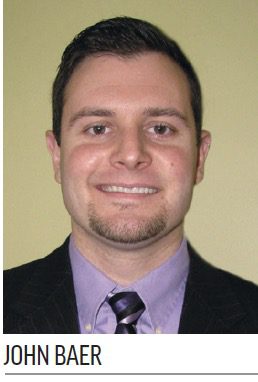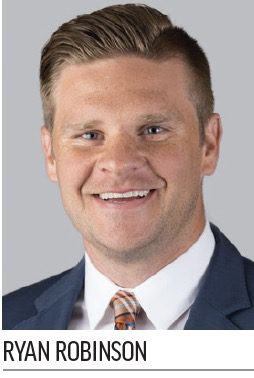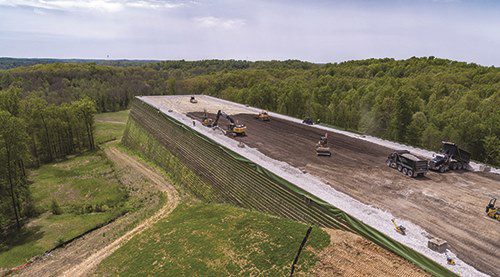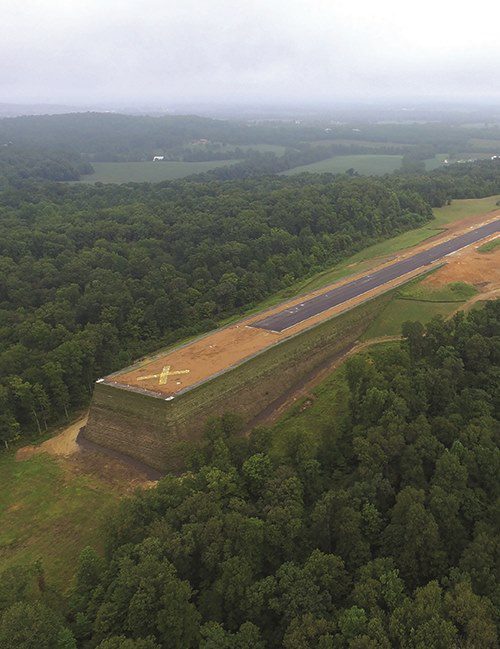Robbie Lambert recalls his flight instructor repeatedly telling him, “If you can land at Paoli, you can land anywhere.” It was a profound statement coming from an experienced veteran who once worked as a bush pilot in Alaska. With practice, Lambert learned to navigate the challenges of Runway 2-20 at Paoli Municipal Airport (I42) in southern Indiana…and now serves as president of the Paoli Board of Aviation Commissioners.
Robbie Lambert recalls his flight instructor repeatedly telling him, “If you can land at Paoli, you can land anywhere.” It was a profound statement coming from an experienced veteran who once worked as a bush pilot in Alaska.
 With practice, Lambert learned to navigate the challenges of Runway 2-20 at Paoli Municipal Airport (I42) in southern Indiana…and now serves as president of the Paoli Board of Aviation Commissioners, which governs the small city-owned airfield.
With practice, Lambert learned to navigate the challenges of Runway 2-20 at Paoli Municipal Airport (I42) in southern Indiana…and now serves as president of the Paoli Board of Aviation Commissioners, which governs the small city-owned airfield.
“Paoli Airport had the shortest runway in our airspace in Indiana,” Lambert recalls. “It was like landing on a matchstick. We were on a hill, we had a line-of-sight issue with a bump on one end, and we often had very windy conditions. There were a lot of variables that made our runway really difficult to land on for even fairly experienced pilots.”
|
facts&figures
Project: Location: Paoli (IN) Municipal Airport Cost: $9.61 million Funding: 90% FAA; 5% state; 5% local (from airport budget) Timeline: 10 years from concept to completion (end of 2020) Consulting Engineers: Woolpert Inc. Engineering Strategy: Create a vegetative mechanically stabilized earth wall to accommodate extension
Wall Construction: 4 years
Construction Contractors: Geotextile Fabric: Tensar Rock Suppliers: Cave Quarries; Calcar Quarry Specialized Grass Seed: Varied by phase, most produced by Caudill Seed Co.
Electromagnetic Conductivity Paving Contractors: Ragle Inc.; Calcar Paving Runway Markings: Elite Line Striping Associated Projects: New LED lighting & precision path indicator system
Lighting & PAPI Manufacturer:
Lighting Contractor: |
But things have improved dramatically. These days, the airport’s sole runway is 508 feet longer and 10 feet wider, measuring 3,301 by 60 feet. The extra length and width make operations much safer, says Lambert. “Due to the shape of the wall, now it’s like landing on an aircraft carrier. We jokingly call it the USS Paoli.”
Adding 10 feet of width was more significant that it may sound. “One side of the runway had a huge drop-off right into the trees,” he explains. “We’ve actually had people run off the runway and go down into the trees. Giving an extra 5 feet on each side of the centerline is helpful, especially when we have a strong crosswind.”
The $9.61 million improvement project, which was set for completion in September, presented significant engineering challenges. Since the runway is on a hill, the airport had to add fill to create a level surface for the extension. Engineers made up the 100 feet of grade difference with a vegetative, mechanically stabilized earth wall. Filled with dirt and surrounded by carefully placed stone, the wall is held together with geotextile fabric and gabion baskets.
The complex process began 10 years ago when the airport first explored extending Runway 2-20. “The reasoning was two-fold,” Lambert explains. “We needed to move forward for safety reasons, and also because nearby French Lick is a tourist area and we wanted to service potential overflow from there.”
Lambert notes that Paoli Municipal keeps fuel prices low to encourage pilots to stop there. But before the recent airfield improvements, some would routinely divert to other airports because they were not comfortable landing on Runway 2-20.
Thinking Outside the Box
Woolpert, the consultant leading design and engineering for the challenging project, began by analyzing the airfield and surrounding property to determine the best way to lengthen the runway. “We knew the extension was needed; we just didn’t know how it was going to happen,” recalls John Baer, associate project manager at Woolpert. “We actually looked at extending one end or another, or even a combination thereof. We opted to build up the whole end of Runway 2 to support the extension. We had to get creative to save money and provide a safe area for aircraft operators to land on.”
 Baer estimates that constructing the wall, as opposed to building farther out to match the grade, saved the airport $2 million to $3 million in dirt and clearing costs. It also proved to be more environmentally friendly because the airfield is surrounded by trees. “To bring in all that dirt to meet the grade, we would have had to clear trees in a massive area,” says Ryan Robinson, project manager at Woolpert.
Baer estimates that constructing the wall, as opposed to building farther out to match the grade, saved the airport $2 million to $3 million in dirt and clearing costs. It also proved to be more environmentally friendly because the airfield is surrounded by trees. “To bring in all that dirt to meet the grade, we would have had to clear trees in a massive area,” says Ryan Robinson, project manager at Woolpert.
Baer adds, “The further we would have had to go with the grading, the more trees would have had to come down. This option saved a pretty significant number of trees.” Creating the wall also protected nearby wetlands. “We cleaned up the wetlands but didn’t build or put fill on top of them, which we would have done if we did not construct the wall,” he remarks.
The wall extends 20 feet underground and rises 80 feet above the surrounding ground level. It was constructed in 18-inch segments—with larger rocks carefully positioned at the base to stabilize the structure’s exterior, and smaller rocks used toward the top.
 The wall’s dirt interior is bound to the exterior rocks by two layers of geotextile fabric, which is surrounded by gabion baskets. “The primary layer goes in between the layers of aggregate every 18 inches,” Robinson explains. “A second layer goes up and around the exterior next to the baskets and interlocks everything in place. When these baskets eventually decompose, the wall will go into tension with the fabric.”
The wall’s dirt interior is bound to the exterior rocks by two layers of geotextile fabric, which is surrounded by gabion baskets. “The primary layer goes in between the layers of aggregate every 18 inches,” Robinson explains. “A second layer goes up and around the exterior next to the baskets and interlocks everything in place. When these baskets eventually decompose, the wall will go into tension with the fabric.”
Tensar, the company that supplied the geotextile fabric, emphasizes that its product is guaranteed against decay and damage from the sun’s ultraviolet rays for 75 years. “We had to make sure that the material we selected met that specific criteria, because if we saw deterioration of that fabric over the years, the wall could collapse,” Robinson notes.
Contractors referenced a conformance checklist throughout construction to ensure that the wall remained within strict structural tolerances. “As you come up, each basket is 6 inches in from the one below it,” says Robinson. “And at the top of the wall, you have to meet that width for the runway safety area. So we had to perform a checklist with 10 different criteria for each point surveyed on every constructed segment, as well as the previously constructed segments to ensure no impact was caused by construction.”
Crews used more than 72,000 cubic yards of rock and 88,000 cubic yards of dirt to create the wall. So much rock was needed that contractors had to construct a road on airport property to transport the heavy material to the runway. “It would have destroyed the ramp and taxiway if the trucks used that pavement to deposit the rock,” Lambert says.

Four Years, Two Contractors
Due to bidding and funding timelines, two separate construction contractors were the low bidder and awarded the work for the project. Although this was not the project team’s preference, Robinson notes that the associated four-year construction timeline allowed ongoing inspection of previously laid layers of the wall. The team also used high-resolution drone imaging by Woolpert’s UAS Group to verify the wall’s structural integrity.
“There was a little bit of risk and liability with multiple contractors performing the work,” Baer comments. “But on the positive side, the wall was constructed over multiple years, which meant that we would have seen any differential settlement if it would have occurred.”
Engineers had the contractors add grass seed to the dirt fill to improve visual acuity for pilots and to help protect the geotextile fabric from sunlight. A special seed mix was used to ensure that the grass will grow to a length that does not require maintenance. The grass is engineered to grow out in spring and early summer, and then die off in the hotter months and during winter. The mixture is comprised of thermally refined wood fiber, crimped interlocking man-made biodegradable fibers, mineral activators and water absorbents. The product is designed to produce rapid germination and dormant seeding, and therefore provide long-term protection for the wall, Robinson explains.
Baer notes that the outer portion of the wall also serves as a “French drain” by facilitating water flow and adding a natural pollution-prevention element that filters sediment out of the runoff.
Construction of the wall began four years ago. In mid-August, contractors were on pace to complete the project by the end of September. Crews are scheduled to finish paving and markings before winter arrives.
Removing This, Improving That
Aside from extending and widening the runway, the airport also removed a troublesome hump in the center of 2-20 caused by a limestone bedrock just below the surface. “It was a visual line-of-sight issue where you couldn’t see the taxiway from the end of the runway,” Baer says.
Crews flattened the 3-foot hump and reconstructed that portion of part of the runway—about 1,110 feet of pavement 50 feet wide. “It is still difficult to see from one end to the other because the elevation still changes 13 feet, but now the runway slopes from south to north without getting higher in the middle,” Robinson explains.
New LED lighting and a four-box precision approach pathway indicator (PAPI) system were other related improvements. “Most airports have two landing PAPI lights, but we actually got approved by the FAA for Runway 2 to have four lights to help give pilots a safer and more accurate glideslope reference,” Lambert says. “With a two-light system, if you have two reds, that means you are low; but it doesn’t tell you how low. With four lights, if you have a white and three reds, you know you are really starting to get low. It is going to give pilots more time to realize they are getting lower than they should be.”
Runway 20 has a traditional two-box PAPI system.
The new runway safety area meets FAA requirements for a 60-foot width of unobstructed surface area on each side and 250 feet long at the departure end of the runway. Millings connected with a cabling barrier system are being installed along the edge of the vegetative mechanically stabilized earth wall to protect personnel mowing grass and performing maintenance.
Surprise!
When workers began preparing the site for construction, they made an unexpected discovery. “We were doing tree clearing and by dumb luck, the team stumbled upon a karst system,” Baer explains.
Naturally, the open underground fissure prompted the team to pause site prep. Given that the airport is located in an area known for limestone deposits, further investigation was required.
“The karst system was in the steepest corner of the wall, and we had big concerns about the potential of caves being under the area where the wall was to be constructed,” Baer explains.
As a result, a specialist performed electromagnetic conductivity mapping and electrical resistivity imaging to assess the condition of the area. Crews drilled 50 feet into the ground in four areas and dropped a video camera down into the holes to survey subsurface conditions.
Additional borings were performed during a geotechnical investigation and fortunately, no other voids were found, prompting the team to conclude that the karst discovered earlier was an isolated anomaly.
Return on Investment
Thanks to federal and state funding, the city’s share for the $9.61 million airfield project was $494,000. That portion was paid out of the airport budget.
Lambert credits its engineering and design consultant for making the complicated project a reality, from start to finish. “The Woolpert team has been fantastic to work with,” he says. “They really seemed to have our best interests at heart.”
In addition to improving runway safety, the recent runway improvements are expected to make Paoli Municipal a more attractive stop for pilots. Specifically, the aviation board hopes to win the business of pilots who need fuel when traveling south for the winter, overflow traffic from the French Lick tourist area or even planes headed to and from the annual EAA fly-in at Oshkosh, WI. The airport’s fixed base operator is ready to accommodate the additional traffic with showers, kitchen facilities and multiple courtesy vehicles for pilots and passengers.
“The airport is also going to help facilitate new pilots by promoting flying,” Lambert adds. “And for even the more experienced pilots, they will now experience the pleasure of flying into Paoli. The economic benefits are strong for pilots and for our community. It’s win-win.”



